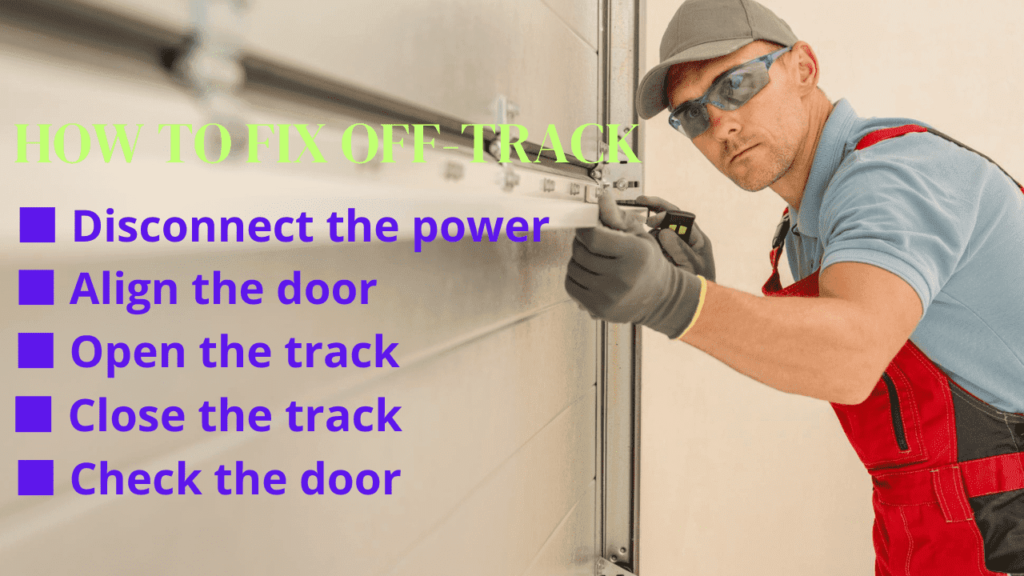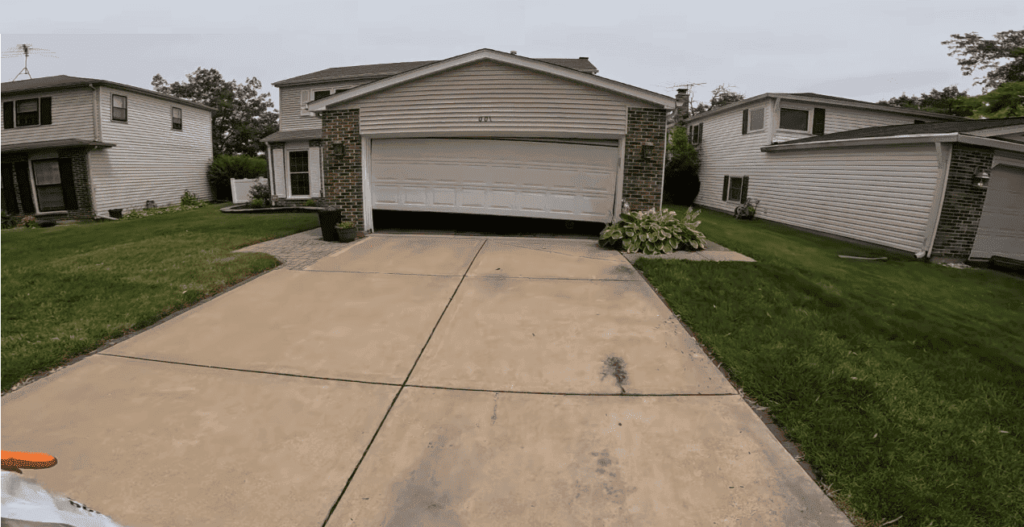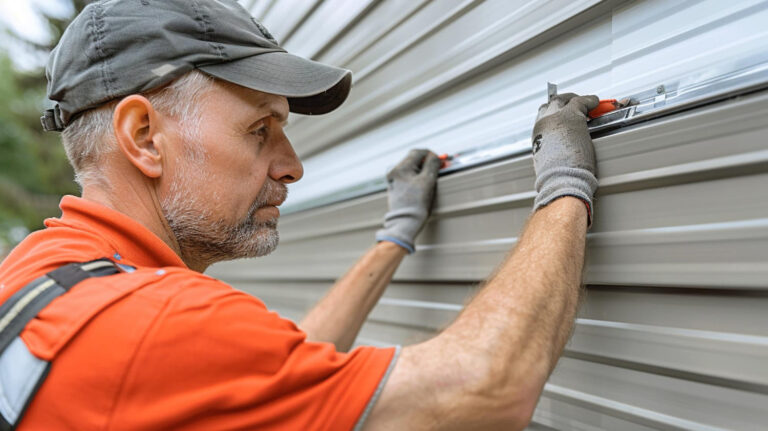Many homeowners have issues with a garage door off track, but you can fix it yourself using the right tools, knowledge, and safety precautions. Usually when your garage door is off track, the rollers have come off of the tracks and caused jamming, unequal movement, or even complete malfunction. Ignoring this problem might lead to more serious safety issues and probable damage to the garage door system. This manual will guide you through the process of resolving the issue and getting your garage door back into proper running order.
1. Understanding Garage Doors Rollers That Are Off Track
Usually either wear and tear on the rollers or tracks, garbage builds in the tracks, or an inadvertent collision with the door results in garage door off-track action. Another common issue with the tracks themselves is their misalignment since it might slide the rollers out. These issues can cause the door to move unevenly, lock, or jam.
A garage door off the track won’t run as expected. It could become caught midway, move sloppily, or create grinding noises when it tries to open or close. Ignoring this could lead to greater damage and perhaps risk the local people’s safety around the garage. Should the door fall totally without control, a perilous situation arises.
Most of the time, replacing a garage door off tracks is a reasonable task for a homeowner with the right tools and safety consciousness. However, it is imperative to identify the exact cause of the problem if one is to avoid future problems.

2. Tools needed
Before attempting any repairs on a garage door off track, you will have to gather the necessary tools to ensure the job is finished safely and correctly. These are some essential tools:
- Pliers: For adjusting and securing components.
- Wrench: To loosen or tighten bolts as necessary.
- Hammer: For gently straightening misaligned tracks or tapping components into place.
- Locking pliers or C-clamps: To secure the door in place while you work on it.
- Ladder: To access the rollers and tracks safely.
- Work gloves: To protect your hands from sharp edges or heavy components.
- Lubricant: Specifically designed for garage doors to ensure smooth movement.
3. Step-by-Step Guide on Fixing a Garage Door Off Track
Step 1: Disconnect the garage door opener.
Starting any garage door off-track repair is disconnecting the garage door opener. Since it prohibits the motor from running the door while you are working on it, this is a somewhat crucial safety measure. Usually a red cord from the opener pulls the emergency release cable to manually operate the door. This enables you to move the door up and down free from worry about the automatic opener engaging.
Step 2: Secure the Door in Place
Following shutting off the opener follows securing the door. Using C-clamps or locking pliers, hold the door in place. Should the garage door off the track stay unlocked, it could move without notice while you are working on it, possibly causing injury or extra damage. Set the locking pliers or C-clamps on the track under the bottom roller to ensure the door remains still all while the repair.
Step 3: Assess the Damage
After locking the door, one can assess the degree of the problem. Look attentively at the tracks and rollers to determine why the garage door roller off track started in the first place. Search the track for any twisted or misaligned pieces, as well as rust or rubbish that could be blocking the rollers. Examining the rollers themselves also helps one find wear or deterioration, including chips or cracks. Usually worn-out rollers, which could have to be changed, are the common causes of a garage door off track.
Step 4: Realign the Tracks
Should you find the tracks bowed or misaligned, you will first have to straighten them before beginning the repair. Tap with a hammer to gently align the tracks. If you hit the rails too hard, you run the danger of doing more damage. Using a level, check the rails to be perfectly vertical and parallel to one another. Stopping future garage door off-tracking demands correct alignment.
Step 5: Place the Rollers Back on Track
The tracks aligned will allow you to guide the rollers back into alignment. Where the garage door is off track will determine the starting point for the roller closest to the location the door came off at. Should the door prove too heavy for you to raise on your own, ask a friend or relative to assist you. Raise the door and carefully guide every roller back into the track. This approach ensures the correct rolling seat, even if it takes time.
Step 6: Tighten the Track Bolts
Once the rolls are back on track, you will have to tighten any loose bolts attaching them to the wall. Loose bolts can cause the tracks to misalign, therefore enabling the door to come off track once more. Using your wrench to tighten every screw ensures the tracks are tightly fastened to the wall.
Step 7: Test the Door
Time comes to test the door following bolt tightening. Once you have pulled the emergency release cable once, you will be able to re-connect the garage door opener and let it operate. Several times open and close the door to ensure smooth track movement. Should the door still struggle to open or close, it could still be misaligned or the rollers could call for extra treatment.
Step 8: Lubricate the Rollers and Tracks
Once you confirm the door is moving without problems, lubricate the rollers and tracks of your garage door. This will reduce friction and ensure the door keeps running as it should. Regular lubrication can help you to extend the lifetime of your garage door system and prevent future garage door off-tracking. Avoid grease since it will attract debris and grime, which could catch the rollers once more.
4. Preventive Maintenance
Your garage door off tracks has been fixed; now, you should be careful not to let the issue come again. Maintaining the running condition of your garage door largely depends on frequent maintenance. These are some preventative steps you could follow:
- Lubricate the rollers and tracks every six months. Every six months, lube the rails and rolls. Maintaining sufficient lubrication of the moving components guarantees smooth operation and helps to reduce roller wear or sticking.
- Inspect and tighten hardware regularly. The nuts and bolts securing your garage door tracks will eventually come free. Make a regular habit of checking and tightening them as needed to avoid misalignment.
- Replace worn-out rollers: If you discover aging rollers are cracked, worn out, or damaged, replace them immediately. Often damaged rollers are the cause of a garage door off-tracking.
- Keep the tracks clean: Dirt and garbage could collect in the tracks and throw the rollers out of alignment. Usually, clear the tracks to ensure flawless mobility.
5. When to Call a Professional
Though a homeowner may manage many garage door off-tracking fixes, sometimes it is advisable to see a professional. The following calls for professional assistance:
- Severely damaged tracks: Extremely damaged or bent tracks could have to be replaced completely should they be too damaged for repair. Should damage be noted, a professional can replace the tracks as necessary.
- Broken springs or cables: Should the issue include damaged springs or cables, it is preferable to let a professional handle the repairs. Given their enormous strain, several of these components can be dangerous to handle.
- Unstable or difficult-to-operate door: Should your garage door continue to be unstable or difficult to operate even after rollers have been corrected, there can be more basic issues with the door’s balance or alignment. Professionally, one can clearly spot and fix the problem.
lastly
Although it might be inconvenient, an off track garage door is a fixable problem generally resolved with the right equipment and careful attention to details. The guidance in this book will help you to safely and successfully fix your garage door. Regular maintenance, which includes lubricating the rollers and preserving the cleanliness of the tracks, can help avoid future problems and ensure that your garage door functions without defects for many years to come.
See a professional right away if the issue persists or if more complicated repairs, such as greatly bent tracks or damaged springs, call for. Early treatment of the problem will extend the life of your garage door system and help to prevent more significant damage.





